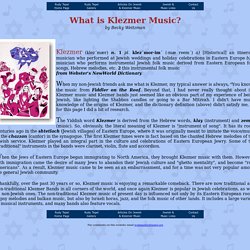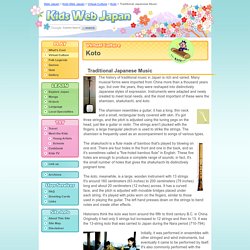

The Real ArgentinaArgentina Wine, Travel, Culture & Food. Daniel Neilson If tango is the soundtrack of Buenos Aires, then it is traditional folklórico that scores the rest of Argentina.

And where the countryside collides with the city is at wine-sloshing musical shindigs called peñas. Peñas in Buenos Aires attract everyone from home-sick northerners from Salta and Jujuy, to city folk who don’t want to get their feet dirty, to students looking for a bit of culture mixed with a lot of fun. Each peña has a slightly different musical angle. The term folklórico is a catch-all term for a lot of traditional music that isn’t tango. The most popular type of music is chamamé originally from Corrientes, an area that attracted a lot of European settlers. The folk movement in Argentina during the 1960s and 1970s developed what is known as the Nueva Canción (new song) that mixed politicised lyrics with an occasionally rockier sound.
Overview of the Music of Argentina, Yesterday and Today. By Tijana Ilich Argentina covers most of the southern half of South America, and is the home of both European and indigenous musical styles.

Settled in the seventeenth century by the Spanish, other Europeans migrated over the next three centuries to make Argentina a true South American melting pot. It’s not surprising that Argentina’s music reflects a wealth of European and indigenous influences. History: In the 20th century, Western Classical Music traditions were explored by such composers as Alberto Ginestera. Genres: Folclore is a general term used for many specific genres of music. ED1. What is Klezmer Music? What is Klezmer Music?

By Becky Weitzman Klezmer (klez´mær) n. 1 pl. klez´mor·im´ (-mæ reem´) a) [Historical] an itinerant musician who performed at Jewish weddings and holiday celebrations in Eastern Europe b) a musician who performs instrumental Jewish folk music derived from Eastern European folk songs, Hebrew melodies, etc. 2 this instrumental folk musicfrom Webster's NewWorld Dictionary When my non-Jewish friends ask me what is Klezmer, my typical answer is always, "You know - the music from Fiddler on the Roof. Beyond that, I had never really thought about it - Klezmer music and Klezmer bands just seemed like an obvious part of my experience of being Jewish, like lighting the Shabbos candles or going to a Bar Mitzvah. Wayan Loceng - Indonesian Traditional Music. Indonesian Music and Dance. By Kallie Szczepanski Across Indonesia, but particularly on the islands of Java and Bali, gamelan is the most popular form of traditional music.

A gamelan ensemble consists of a variety of metal percussion instruments, usually made of bronze or brass, including xylophones, drums and gongs. It may also feature bamboo flutes, wooden stringed instruments, and vocalists, but the focus is on the percussion. The name "gamelan" comes from gamel, a Javanese word for a type of hammer used by a blacksmith.
Gamelan instruments are often made of metal, and many are played with hammer-shaped mallets, as well. Although metal instruments are expensive to make, compared with those of wood or bamboo, they will not mold or deteriorate in Indonesia's hot, steamy climate. Origins of Gamelan: Gamelan seems to have developed early in the history of what is now Indonesia. continue reading below our video. Traditional Japanese Music 1. Traditional Japanese Music - Koto - Virtual Culture. The history of traditional music in Japan is rich and varied.

Many musical forms were imported from China more than a thousand years ago, but over the years, they were reshaped into distinctively Japanese styles of expression. Instruments were adapted and newly created to meet local needs, and the most important of these were the shamisen, shakuhachi, and koto. The shamisen resembles a guitar; it has a long, thin neck and a small, rectangular body covered with skin. It's got three strings, and the pitch is adjusted using the tuning pegs on the head, just like a guitar or violin. The strings aren't plucked with the fingers; a large triangular plectrum is used to strike the strings. The shakuhachi is a flute made of bamboo that's played by blowing on one end. The koto, meanwhile, is a large, wooden instrument with 13 strings. Historians think the koto was born around the fifth to third century B.C. in China.
What is Celtic music? History It is widely acknowledged that African music has undergone frequent and decisive changes throughout the centuries. What is termed traditional music today is probably very different from African music in former times. Nor has African music in the past been rigidly linked to specific ethnic groups. The individual musician, his style and creativity, have always played an important role. The material sources for the study of African music history include archaeological and other objects, pictorial sources (rock paintings, petroglyphs, book illustrations, drawings, paintings), oral historical sources, written sources (travelers’ accounts, field notes, inscriptions in Arabic and in African and European languages), musical notations, sound recordings, photographs and motion pictures, and videotape.
In ancient times the musical cultures of sub-Saharan Africa extended into North Africa. Get unlimited access to all of Britannica’s trusted content. Gerhard KubikDonald Keith Robotham Lutes. African music.